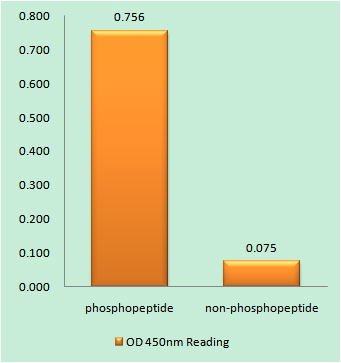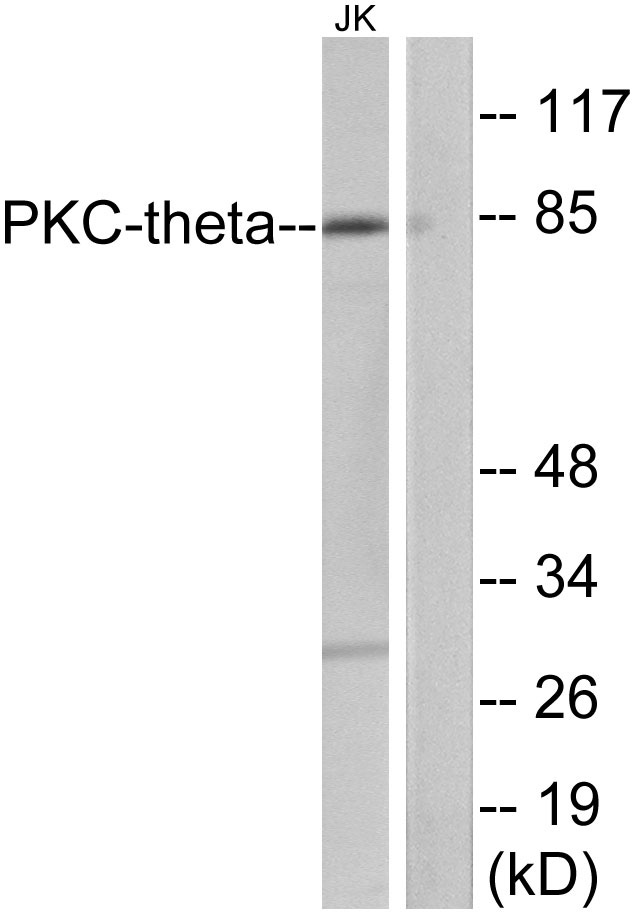Phospho PKC θ (S676) Cell-Based Colorimetric ELISA Kit
- Catalog No.:KA1639C
- Applications:ELISA
- Reactivity:Human;Mouse;Rat
- Gene Name:
- PRKCQ
- Human Gene Id:
- 5588
- Human Swiss Prot No:
- Q04759
- Mouse Swiss Prot No:
- Q02111
- Rat Swiss Prot No:
- Q9WTQ0
- Storage Stability:
- 2-8°C/6 months
- Other Name:
- Protein kinase C theta type (EC 2.7.11.13) (nPKC-theta)
- Detection Method:
- Colorimetric
- Background:
- catalytic activity:ATP + a protein = ADP + a phosphoprotein.,cofactor:Magnesium.,domain:The C1 domain, containing the phorbol ester/DAG-type region 1 (C1A) and 2 (C1B), is the diacylglycerol sensor and the C2 domain is a non-calcium binding domain.,enzyme regulation:Three specific sites; Thr-538 (activation loop of the kinase domain), Ser-676 (turn motif) and Ser-695 (hydrophobic region), need to be phosphorylated for its full activation.,function:PKC is activated by diacylglycerol which in turn phosphorylates a range of cellular proteins. PKC also serves as the receptor for phorbol esters, a class of tumor promoters.,function:This is a calcium-independent, phospholipid-dependent, serine- and threonine-specific enzyme. Essential for T-cell receptor (TCR)-mediated T-cell activation, but is dispensable during TCR-dependent thymocyte development. Links the TCR signaling complex to the activation of NF-kappa-B in mature T lymphocytes. Required for interleukin-2 (IL2) production.,PTM:Autophosphorylation at Thr-219 is required for targeting to the TCR and cellular function of PKC upon antigen receptor ligation.,similarity:Belongs to the protein kinase superfamily.,similarity:Belongs to the protein kinase superfamily. AGC Ser/Thr protein kinase family. PKC subfamily.,similarity:Contains 1 AGC-kinase C-terminal domain.,similarity:Contains 1 C2 domain.,similarity:Contains 1 protein kinase domain.,similarity:Contains 2 phorbol-ester/DAG-type zinc fingers.,subunit:Interacts with TXNL2/PICOT.,tissue specificity:Skeletal muscle, megakaryoblastic cells and platelets.,
- Function:
- regulation of cell growth, response to hypoxia, regulation of cytokine production, positive regulation of immune system process, regulation of leukocyte activation, positive regulation of leukocyte activation, protein amino acid phosphorylation, proteolysis, membrane protein ectodomain proteolysis, phosphorus metabolic process, phosphate metabolic process, intracellular signaling cascade, regulation of mitotic cell cycle, aging, positive regulation of cell proliferation, macromolecule catabolic process, response to temperature stimulus, response to heat, response to wounding, response to abiotic stimulus, response to endogenous stimulus, response to hormone stimulus, response to carbohydrate stimulus, response to hexose stimulus, response to glucose stimulus, positive regulation of biosynthetic process, response to organic substance, regulation of G2/M transition of mitotic cell cycle, p
- Subcellular Location:
- Cytoplasm. Cell membrane; Peripheral membrane protein. In resting T-cells, mostly localized in cytoplasm. In response to TCR stimulation, associates with lipid rafts and then localizes in the immunological synapse.
- Expression:
- Expressed in skeletal muscle, T-cells, megakaryoblastic cells and platelets.
- June 19-2018
- WESTERN IMMUNOBLOTTING PROTOCOL
- June 19-2018
- IMMUNOHISTOCHEMISTRY-PARAFFIN PROTOCOL
- June 19-2018
- IMMUNOFLUORESCENCE PROTOCOL
- September 08-2020
- FLOW-CYTOMEYRT-PROTOCOL
- May 20-2022
- Cell-Based ELISA│解您多样本WB检测之困扰
- July 13-2018
- CELL-BASED-ELISA-PROTOCOL-FOR-ACETYL-PROTEIN
- July 13-2018
- CELL-BASED-ELISA-PROTOCOL-FOR-PHOSPHO-PROTEIN
- July 13-2018
- Antibody-FAQs



